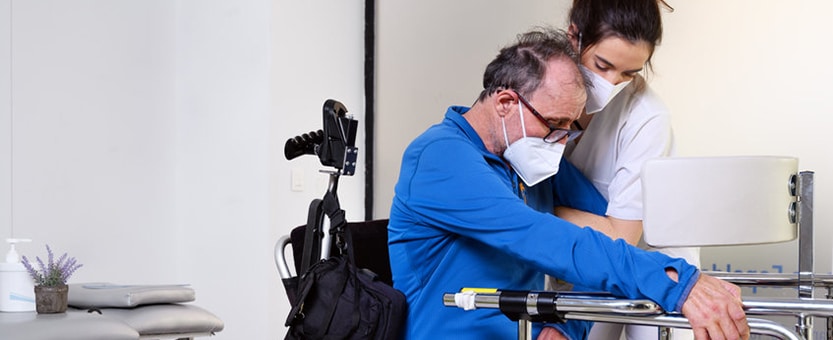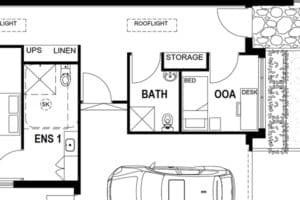-
1300 994 890Property Management1300 832 373Consulting & Certification
Where can OOA or Onsite Overnight Assistance be located?

An issue that regularly comes up when doing assessments of Specialist Disability Accommodation is the location of the OOA or Onsite Overnight Assistance area for Fully Accessible and High Physical Support participants.
 The NDIS Specialist Disability Accommodation Design Standard is silent on any provisions for OOA. In fact, neither the SDA Design Standard nor the Pricing Arrangements for Specialist Disability Accommodation provide any guidance on where OOA shall be located or what shall be provided within the space.
The NDIS Specialist Disability Accommodation Design Standard is silent on any provisions for OOA. In fact, neither the SDA Design Standard nor the Pricing Arrangements for Specialist Disability Accommodation provide any guidance on where OOA shall be located or what shall be provided within the space.
In December 2021, the Accredited SDA Assessor – Update 4 was issued to all Accredited SDA assessors. This update included Clarifications re the SDA design standard interpretations. One of the key items that was included was the requirements for OOA as follows.
Clarification Item 16: Onsite Overnight Assistance
Question: Can an OOA room be provided within an FA or HPS dwelling with only stairway access available to the OOA room?
Answer: No. Where OOA is provided within an FA or HPS dwelling there, it is required to be on a level accessible to the participant.
This means the OOA room must be accessible by either providing it on the entry level or should the OOA room be located on the first floor, lift access must be provided noting all areas of HPS and FA dwellings must be fully accessible to the participants.
Provision of OOA
Identify if there is a room for On-Site Overnight Assistance
- The On-site Overnight Assistance (OOA) amount is only paid when an additional room is used by support staff who provide support services overnight to participants living in the same dwelling that contains the OOA room or in a near-by dwelling.
- The form of OOA varies between Building Type and the amount of the OOA assistance payment made in relation to this room, as a consequence, may depend on whether access to the OOA is shared between multiple dwellings.
- Table 6 describes the OOA and when OOA is payable.
Additional Clarifications for OOA
Further, frequently asked questions relating to Onsite Overnight Assistance (OOA) is addressed below:
Question: To claim OOA funding for apartments can an OOA room be provided instead of a full apartment?
Answer: No. Where OOA funding is claimed for an apartment, the OOA needs to be a full apartment which would generally consist of a bedroom, living room, kitchen and bathroom. A studio-style apartment can used for OOA.
Question: I have a 3 Bedroom SDA apartment with only 2 Participants. Can I use the third bedroom for OOA?
Answer: This scenario is not permitted for OOA payment in apartments under The NDIS Pricing Arrangements for Specialist Disability Accommodation (previously the Price Guide for Specialist Disability Accommodation).
Question: I have 15 SDA Apartments that require OOA. Can I claim OOA payment for all 15 SDA apartments if I provide one OOA apartment?
Answer: OOA is paid per maximum of 10 SDA units. Therefore, if 15 SDA units are to receive the OOA funding, 2 OOA units will be required. If only one OOA is provided, then OOA would be payable to 10 SDA units only. No payment would be available for the additional 5.
Question: Can an OOA room be designed as an office without a bed provided?
Answer: There are no set requirements for the provision of a bed in an OOA room, though it is important to remember that the OOA room will be used by the SIL provider to be on-site (24 hours). Therefore, even though not mandated, it is recommended that space for a bed in the OOA room is provided.
Clarification Item 2:
Clause 4 Entrance, doorways, and door hardware: Clause 4.2.1, 4.2.2, 4.2.3 The term ‘all areas normally used by the participant’ means all areas in the participant’s home. Clause 4.1.3 requires door circulation spaces to all areas excluding storage and exclusive staff use areas.
For example, it is reasonable in FA and HPS design categories to have an onsite overnight assistance room without the specified door circulation spaces, however, the clear door opening requirements still apply so that access is not restricted to an area of a participant’s own home. This also applies to an ensuite, or bathroom used exclusively by the support staff where located within the participant’s home.
No design requirements apply where OOA is a separate apartment in a residential apartment building.
Bruce has over 32 years of experience in disability access, architectural design, documentation & project management
He formed Equal Access Pty Ltd in 2006 in response to growing recognition, that whilst businesses were being urged to respond to their obligations under the Disability Discrimination Act, the majority of assistance available was focused almost entirely upon the needs of the individual with a disability without an understanding of the impacts and practicalities for building owners, managers and consultants.
Bruce also specialises in evacuation procedures and policy for people with a disability and is a member of the Standards Australia development committee FP-017 Emergency Management Planning – Facilities (AS3745)
Categories
Recent Posts
- There will be fatalities! It’s not if, but when!
- Creating Accessible and Inclusive Housing: Universal Design in SDA
- Understanding Luminance Contrast and Colour Contrast for SDA
- Disability Fire Safety Forum: Specialist Disability Accommodation
- Converting an Existing House to Specialist Disability Accommodation


